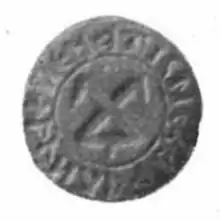Radič Sanković | |
|---|---|
| knez, duke | |
 Seal of Radič Sanković, 1391 | |
| Predecessor | Sanko |
| Successor | extinct |
| Born | Zaborani hamlet of Glavatičevo (now part of Nevesinje municipality) |
| Died | 1404 Blagaj |
| Noble family | Sanković |
| Spouse | Goisava Balšić |
| Father | Sanko Miltenović |
| Occupation | military commander |
Radič Sanković (Serbian Cyrillic: Радич Санковић; died 1404) was powerful Bosnian nobleman and magnate in the Kingdom of Bosnia during the reign of Stephen Dabiša (1391-1395) and Queen Helen (1395-1398). He allied himself with usurper Stephen Ostoja (1398-1404) during the civil wars, until his death in 1404. With the title of vojvoda (transl. duke; general), he held territories in present-day Herzegovina, including Župa Valley with Glavatičevo as its center, Nevesinje, parts of Popovo Polje and most of Konavle.
Life
Radič was the son of Sanko Miltenović, the eponymous founder of the House of Sanković (the progenitor was Dražen Bogopenec,[1] a lord of Hum under King Stephen Uroš II Milutin of Serbia, fl. 1306). He and his brother Beljak inherited the lands of Nevesinje and Popovo Polje (in Herzegovina) and part of Konavli (southernmost Dalmatia) upon the death of his father. He had brothers Beljak, Budelja, Sančin and sister Dragana. In 1388, he and fellow nobleman Vlatko Vuković led the Bosnian army against the Ottomans at Bileća.[2]
In 1392, Radič and Beljak tried to sell Konavli to the Republic of Ragusa.[3] The same year on May 15, he issued a charter to Dubrovnik merchants enabling them to trade on his territories.[4] However, a council meeting was convoked by the king and nobility who objected the sale.[5] Grand duke Vlatko Vuković (of Kosače) and knez Pavle Radinović (of Pavlovići) were sent against Radič in December 1391 after receiving the council's blessings.[5] The two captured Radič and occupied Konavli, dividing it between themselves, despite protests from Ragusa.[5] Vuković died shortly after this, and was succeeded by his nephew Sandalj Hranić, who continued to struggle against Radič.[5] Radič regained freedom in 1398, immediately seeking to restore his lost lands, becoming an important ally of Stephen Ostoja.[6] In 1399, he sold the Lisac field to Ragusa for 500 perpers.[7] He also became a member of the Ragusan Great council. Radič participated in the Bosnian-Dubrovnik War in 1403-1404, leading the attacks on Dubrovnik in the name of Ban Stjepan Ostoja. Hranić captured and blinded Radič, and held him in prison until his death in 1404.[5] The area of Nevesinje to the coast was taken by Hranić.[5]
References
Sources
- Fine, John Van Antwerp Jr. (December 1975), The Bosnian Church: a new interpretation: a study of the Bosnian Church and its place in state and society from the 13th to the 15th centuries, East European quarterly, ISBN 978-0-914710-03-5, retrieved 12 January 2013
- Fine, John Van Antwerp Jr. (1994). The Late Medieval Balkans: A Critical Survey from the Late Twelfth Century to the Ottoman Conquest. The University of Michigan Press. ISBN 0-472-08260-4.
- Klaić, Vjekoslav (1882). Poviest Bosne do propasti kraljevstva. Tiskom Dioničke tiskare.
- Mišić, S. (2008). Povelja Beljaka i Radiča Sankovića Dubrovniku. Stari srpski arhiv, (7), 113-127.